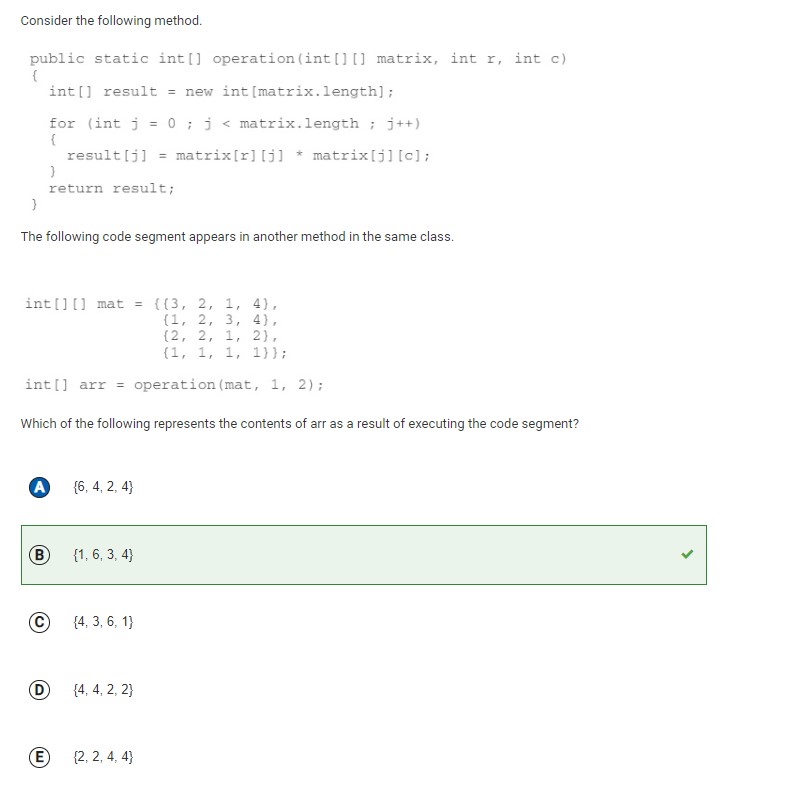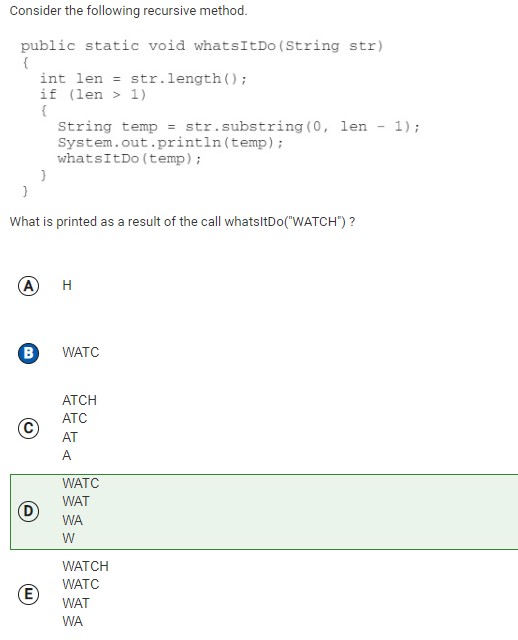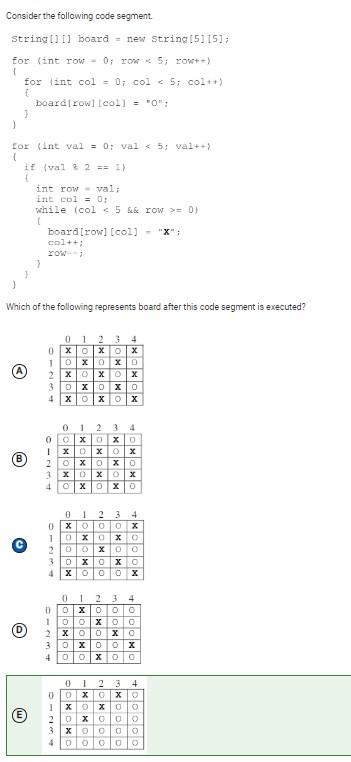MCQ 2015
Corrections + Score
2015 MCQ Score
Quiz:


C is correct: The outer loop iterates six times for when outer is assigned the values 1 through 6. For each iteration, the number of times the inner loop iterates is dependent on the value of outer. When outer is 1, the inner loop iterates from 1 to 6, incrementing by 1 each time, and prints all even numbers followed by a space (2 4 6). When outer is 2, the inner loop iterates from 2 to 6 and prints all even numbers followed by a space (2 4 6). When outer is 3, the inner loop iterates from 3 to 6 and prints all even numbers followed by a space (4 6). When outer is 4, the inner loop iterates from 4 to 6 and prints all even numbers followed by a space (4 6). When outer is 5, the inner loop iterates from 5 to 6 and prints 6 followed by a space. When outer is 6, the inner loop iterates one time and prints 6 followed by a space.

B is correct: In the first iteration of the for loop, j is 0. The value of result[0] is assigned the product of row 1, column 0, which is 1 and row 0, column 2, which is 1. Therefore, result[0] is assigned the value 1. The second iteration of the for loop, when j is 1, result[1] is assigned the product of row 1, column 1, which is 2, and row 1, column 2, which is 3. Therefore, result[1] is assigned the value 6. The third iteration of the for loop, when j is 2, result[2] is assigned the product of row 1, column 2, which is 3, and row 2, column 2, which is 1. Therefore, result[2] is assigned the value 3. The final iteration of the for loop, when j is 3, result[3] is assigned the product of row 1, column 3, which is 4, and row 3, column 2, which is 1. Therefore, result[3] is assigned the value 4.

D is correct: During each recursive call to whatsItDo, temp is assigned a substring of the parameter that excludes the last character, then prints this to the screen and calls whatsItDo with this substring. For the first recursive call, whatsItDo(“WATCH”) will print WATC and call whatsItDo(“WATC”). The call whatsItDo(“WATC”) will print WAT and call whatsItDo(“WAT”). The call whatsItDo(“WAT”) will print WA and call whatsItDo(“WA”). The call whatsItDo(“WA”) will print W and call whatsItDo(“W”). Since the length of string “W” is not greater than 1, the recursive method is complete.

E is correct: The first set of nested for loops sets each element in board to “O”. The next for loop starts val at 0 and increments by 1 until val is 4, when val is 5 the loop terminates. When val is even, board is not updated, so nothing happens when val is 0. When val is 1, row is assigned 1 and col is assigned 0. The boolean condition in the while loop is true, so board[1][0] is assigned “X”. Then col is incremented to 1 and row is decremented to 0 and board[0][1] is assigned “X”. Then col is incremented to 2 and row is decremented to -1 and the while loop terminates. When val is 2, nothing changes about board. When val is 3, row is assigned 3 and col is assigned 0. The boolean condition in the while loop is true, so board[3][0] is assigned “X”. Then col is incremented to 1 and row is decremented to 2 and board[2][1] is assigned “X”. Then col is incremented to 2 and row is decremented to 1 and board[1][2] is assigned “X”. Then col is incremented to 3 and row is decremented to 0 and board[0][3] is assigned “X”. Finally, col is incremented to 4 and row is decremented to -1 and the while loop terminates. When val is 4, nothing changes about board.